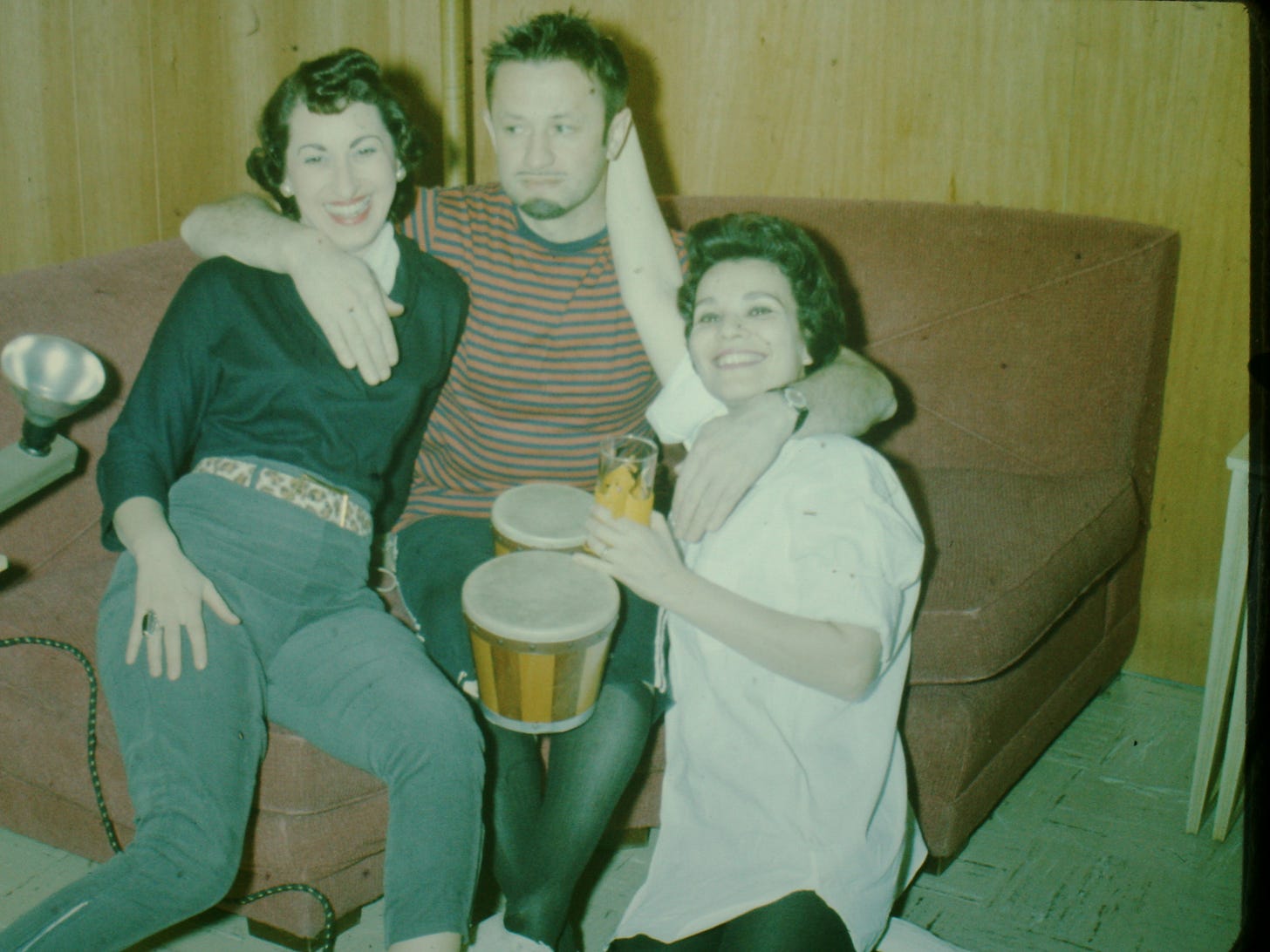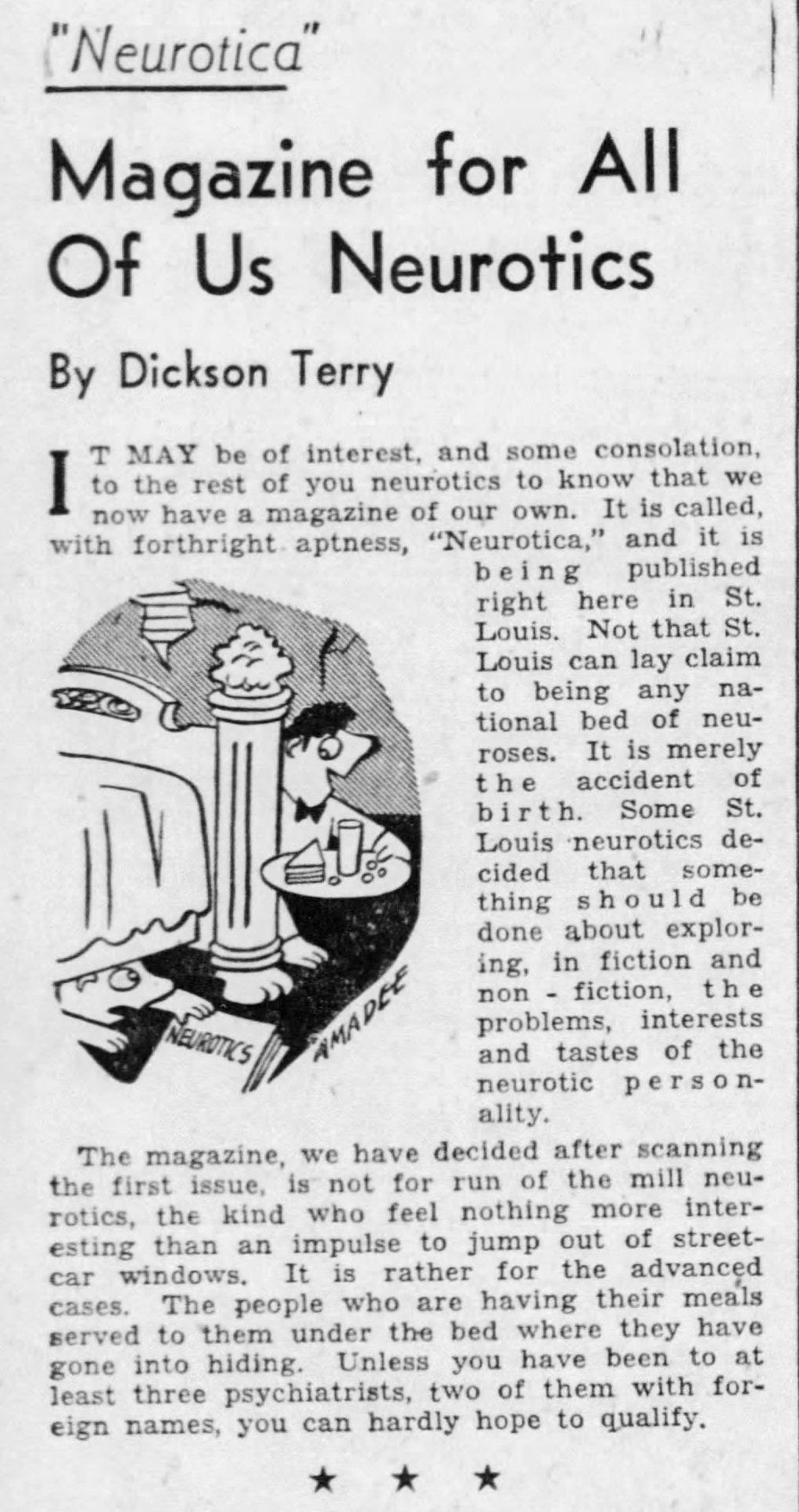Without St. Louis, there would be no hipsters
And not because of William S. Burroughs, either.

When people say, “St. Louis created the Beat Generation,” it’s likely they’re talking about the prurient story of David Kammerer and Lucien Carr, dramatized in 2013’s Kill Your Darlings. If you’re not familiar, it tells the story of how St. Louis natives Lucien Carr and William S. Burroughs crossed paths with Allen Gisberg and Jack Kerouac in New York City — and how Carr murdered another St. Louisan, David Kammerer, allegedly because Kammerer was stalking him.
I have a weak stomach for violence, and I struggled to re-adjust my vision and see Daniel Radcliffe as Ginsberg, not Harry Potter, so I skipped it. I’d also recently visited Bellefontaine Cemetery, where a docent pointed out David Kammerer’s grave, noting it had been “lost” for decades. There are accounts suggesting Carr played Kammerer’s obsessive behavior to his own ends, extorting him for money and food. The whole thing just felt so sad and seedy and depressing. I’ll take a pass.
When I think about Beat culture and its connection St. Louis, I’d much rather think about a goofball named Jay Landesman, who could by his own admission be lazy, meandering and thoughtless. But he never stabbed anyone, and never shot anyone in the head playing William Tell.
Just by living his life, Landesman accidentally cast the die for what much of what’s come to define a hipster, including the bongo-pounding, soul-patched 1950s version of the beatnik and the 21st century dirtbag hipster. (Mr. Ginsberg gets the credit for mainstreaming the word with his famous — infamous? — poem, “Howl,” and its mention of “angelheaded hipsters.”)
Landesman’s best known for his role in opening The Crystal Palace and helping to form the identity of St. Louis’ Gaslight Square, but before that, he frequented, and cast his destiny with, Little Bohemia, one of the city’s first countercultural districts. I didn’t know anything about it until I wrote a story about it for St. Louis Magazine. It took weeks of digging around in archives and getting help from folks like Bob Moore, resident historian at the Arch grounds, to find much of anything. The city cleared the neighborhood wholesale back in the 1930s, and without a physical environment to remind us it existed, Little Bohemia largely went down the memory hole.
Landesman is the missing link between Little Bohemia and Gaslight Square — he befriended painter Savo Radulović, owner of Little Bohemia, the art bar that gave the area its name.
The first iteration was on the Riverfront, on Commercial Street, and was torn down to make way for the Gateway Arch. Here’s the short-lived downtown location:

These days, it’s easy for us to assemble chosen families and live unconventional lives. We forget that as recently as the mid-20th century, bucking convention exacted a sharp cost, socially and otherwise. In his memoir, Rebel Without Applause, Landesman writes about attempting to be a domestic fellow. He ties the knot with a woman named Pat; they honeymoon in NOLA. He immediately realizes his marriage will be a slow-moving disaster. It becomes a fast-moving one as soon as he partners with Radulović on the bar.
He also writes a about the anxiety of being a free spirit in the Midcentury Midwest, and how it planted the seeds for one of the most influential alternative publications in American history:
Once we were settled, our open house hospitality attracted the best collection of rejects St. Louis literary, artistic and musical life had to offer. The only price of admission was a healthy maladjustment to society; an interesting neurosis was an added bonus. ‘Square’ was the dreaded word. To be ‘serious’ was to leave yourself open to attack without chance of survival.
One of the rejects in that circle was Richard Rubenstein, who Landesman describes as “a full-time neurotic and part-time poet from a rich family that had never heard of Rimbaud.” One day, Rubenstein showed up on Landesman’s doorstep with W.H. Auden’s The Age of Anxiety in hand.
“The poet is the first to recognize the rot, the first to celebrate the glory, and the last to be appreciated,” Rubenstein told him. “Let’s cure the ills of America by starting a poetry magazine.”
“Your rejection slips are showing,” Landesman replied. “You’ll never get laid with a poetry magazine.”
Rubenstein didn’t laugh. He predicted “the new look is going to be the anxious look.”
Landesman embraced the anxious look — literally. And it sounds a lot like your standard-issue, 21st-century dirtbag hipster:
“I grew a beard,” he writes. “I hid the upper half of my face with dark glasses. My clothes sense deserted me. I longed for those hand-me-downs that had made my life so miserable. I put the two-tone saddle shoes in the back of the closet and slipped into a pair of dirty sneakers. The crew cut look had to go. Long hair was the mark of the Wild West, and the pioneer look is what I was after. Instead of a covered wagon, I bought a convertible Model A Ford with a roof so patched and torn it looked like something out of Grapes of Wrath.”
The literary version of the anxious look started as a joke. Landesman had already printed up some fake business cards annoucing a quarterly journal, Neurotica, after asking his friends about his defining personality trait (neurosis). A few days after Rubenstein proposed starting a little magazine, Landesman threw one at him while they were drinking.
“His mouth just about fell off his face,” Landesman wites. “He sat there, staring at the card, mouthing the syllables NEU-RO-TI-CA as if it was some kind of new catechism.”
The first issue was put together in St. Louis and sent out across the country in March of 1948. It was written up in TIME and the St. Louis Post-Dispatch. As you can see, it was described more as a layperson’s psychology journal rather than a lit mag:
By the second issue, Landesman had landed in Greenwich Village, and through St. Louis connections, crossed paths with the Beats. Neurotica was the first little magazine to publish Allen Ginsberg’s work. The Boston Review argues that Neurotica was the Beats’ home journal.
All respect to Ginsberg, but there’s a more interesting character linked to Neurotica: the mostly forgotten Gershon Legman, America’s leading expert on the psychology of the dirty joke. His theory, which he explained in the pages of Neurotica, was that America’s extreme fixation on blood, gore and violence was pathological, and due to blunted libidos. (He’s apparently the guy who came up with the slogan “Make Love, Not War.”)
At the suggestion of a New York friend, Landesman agreed to meet up with Legman to talk about some editorial collaboration. Here’s Landesman’s account of taking the subway to the Bronx to meet Legman for the first time:
“Are you Landesman? I’m Legman.” The tone of his voice was sinister. As he stepped from the shadows, I saw a heavily moustached, portly figure, with a wild shock of hair that made me think of a young Balzac. I knew immediately that there weren’t going to be any laughs in the Bronx that night.
Landesman and his entourage followed Legman back to his house, passing the butcher where Legman bought sheep lung, arriving at what was apparently the last cottage in the Bronx, former home to supernatural writer Charles Forte.
“A lot of unexplained things still happening around here,” Legman tells them. “Ghosts and all that crap.”
Landesman spends a few hours at Legman’s cottage, where books were piled so high they were used as furniture. Legman berated him, telling him Neurotica is “garbage” and lecturing him about the ills of American society:
“The generation of children born since 1930 cannot read!” You don’t believe it?” He threw some comics on the table with horrible illustrations of brutality. “Sex has been replaced by violence…Debasement of women, murder movies, muder magazines, murder books — writers have created a whole generation of children brought up on violence. Is it any wonder there’s no place for decent, healthy emotion?
Of course, Landesman being Landesman, he decided Legman was the perfect collaborator, despite members of his entourage warning him that he was about to commence working with “a nut case.”
The two nearly strangled each other at certain points, but not before they created the template for what would become, in later iterations, alt-press publications and zines. Neurotica was the first national magazine to freely publish works using swear words, the first to openly describe drug use, and one of the the first really sucessful literary magazines that didn’t have roots in academia. The next time you find a zine you like, thank Landesman — and Legman.
Next time I write about Little Bohemia, I’ll write about a person who’s even more interesting than Jay Landesman: Anne Dick, ex-wife of sci-fi writer Philip K. Dick, and widow of Richard Rubenstein. She grew up in St. Louis, and is the person who exposed Dick to Greco-Roman mythology and changed the trajectory of his career. I’d say we have her to thank for Blade Runner, and in a way, the whole modern sci-fi industrial complex. (Tell me Andor isn’t the most Dickian thing to come out of Disney so far!)
Anne Dick was also an artist and a poet herself — which does get mentioned in her New York Times obit, though she’s still described primarily as muse, rather than as an artist in her own right, as if being Phil Dick’s wife was the nost interesting milestone in her life. Well: I’d say not by a long shot. But that’s the topic for another day.





Your essays are so full of detail, so many juicy tidbits! I want to do research on several things at once, but I leave it in your hands. :) I do need to know more about Alice Dick. And Andor is 100% Dickian. Dickian, Dickian, Dickian. Heenh.
Joan Vollmer
Edie Parker
William S. Burroughs
Photo cache discovery
https://youtu.be/F18hfy1BUR0